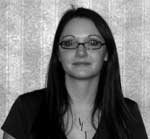
NEADS Conference 2004 - Right On!
Speakers
Kimberley Gerritsen

|
Biography
Kimberley Gerritsen is currently a graduate student at the University of Calgary working on a Masters of Education in Community Rehabilitation and Disability Studies. She has an undergraduate degree in Elementary Special Education from the University of Alberta and works with children with all types of disabilities, including those with print disabilities.
Audio
PowerPoint
Synopsis
Unique Challenges: Living with an Invisible Print Disability
This presentation will focus on Kimberley’s personal experiences as a person with a print disability, both in academic life and in day-to-day living. Kimberley will focus primarily on the use of technologies and organizations that provide alternate formats and explain how individuals can prepare materials in alternate formats. This presentation will also focus on the invisibility of print disabilities and the process of transitioning from high school to undergraduate to graduate studies.
Report
Kimberley Gerritsen, Graduate Student, Masters of Education in Community Rehabilitation and Disability Studies, University of Calgary, spoke about her personal experience with print disability. Her print disability is the result of a learning disability (LD) rather than of a visual impairment. She described LD as a disruption in the learning process, which has four stages:
- Receiving information via the senses
- Processing the received information in the brain
- Turning the result into memory
- Expressing what is remembered
Visual processing deficits come in four main types:
- Visual figure–ground deficit: Difficulty seeing a specific image within a competing background, difficulty picking out specific lines on a page, or words on a line
- Visual sequencing deficit: Difficulty seeing things in the correct order, seeing letters or words in reverse
- Visual discrimination deficit: Difficulty seeing the difference between two similar objects such as c’s and e’s, n’s and m’s, etc.
- Depth perception deficit: Difficulty perceiving how far away an object may be
Gerritsen asked a volunteer from among the workshop participants to read a story entitled “The Farmer and the Mule”, which was written out this way:
The Farner the amb Mule: A baradle told of farner ownep who olb mule. The nule mule stanb eoulp on the dotton. The farmer heard mule braying-whatcver mvlcs bo when …
She explained that the text showed how a person with an LD and a related print disability (difficulty seeing the difference between two similar objects, such as “p” and “b” or “u” and “v”) would see words on a page. In the story, the happy ending communicated the moral: What seems like something that could bury a person can actually help, because life is about how we handle adversity.
Gerritsen concluded her presentation by outlining the three available options for accessing print material in audible format:
- Organizations such as RFB&D, public libraries, and the CNIB
- Paying readers or enlisting the support of volunteer readers
- Technology, such as the Zoomtext program, which is designed for people with a visual impairment. Kurzweil is a program designed for people without a visual impairment.